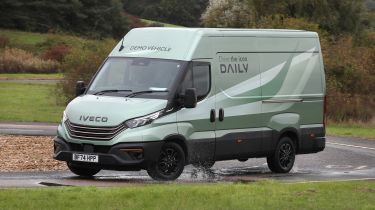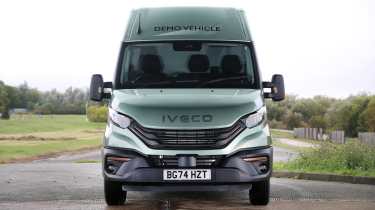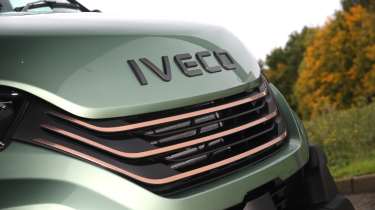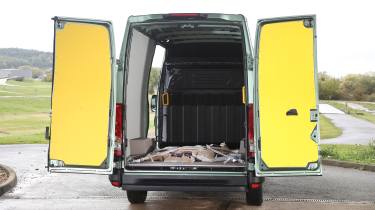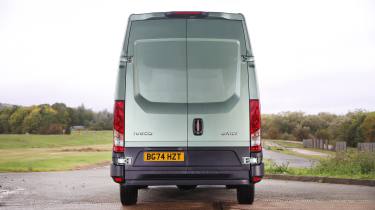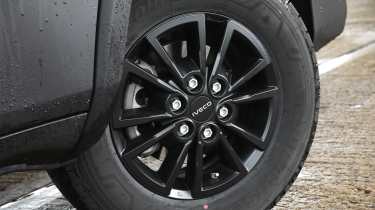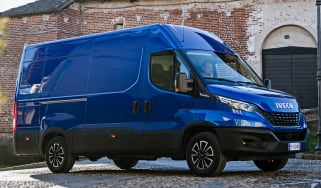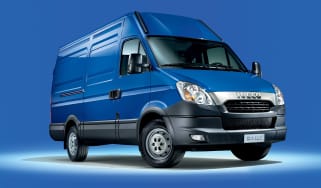Iveco Daily van review
The latest Iveco Daily is as capable as ever, but some rivals feel more sophisticated
About the Iveco Daily
As with many other vans of various shapes and sizes, the latest Iveco Daily looks remarkably similar to the model it has replaced. Fortunately, the previous Daily was already a capable machine thanks to its body-on-frame construction and seemingly endless customisation options.
The Daily’s basic design can be traced back to 2016, so it was inevitable that the on-board tech, features and powertrains would all be destined for modernisation. Today, diesel power is still on offer, courtesy of 2.3-litre or 3.0-litre engines — both of which are available with varying power outputs ranging from 114bhp right up to 204bhp — but with an increasing number of businesses looking to reduce their emissions (and subsequent running costs) the 3.0-litre engine also comes with the option of compressed natural gas (CNG) power. For those who want to completely cut out their exhaust emissions, a fully electric Iveco e-Daily is also available.
Unlike some electric rivals, the Iveco e-Daily actually offers the same cargo capacities and towing limits as the diesel, so there are far fewer sacrifices that need to be made by those wanting battery power.
The Daily’s ladder-frame chassis means there’s a large number of body variations to choose from, along with three lengths of wheelbase. Panel van, luton van, chassis cab and crew cab set-ups are all offered, along with a minibus and even a 4x4 model.
More reviews
In-depth reviews
Once you’ve decided on shape, there are up to three different wheelbases and five body lengths to pick from, with the gross vehicle weight ranging from 3.5 to 7.2 tonnes. Of course, if you have a standard UK driving licence that was issued from 1997 onwards, you’ll only be able to drive the 3.5-tonne models.
The panel van is also available in three different heights. Opting for the longest and largest version gives you a whopping cargo capacity of 19.6 cubic metres, but even the smallest model still offers a reasonable 7.3 cubic metres.
Along with its potentially huge carrying capacity, all Iveco Dailys (including the electric model) can also tow up to 3,500kg braked.
When it comes to carrying people, the cabin should be familiar to anyone who’s been in a Daily before. One key difference is the new 10.25-inch digital instrumentation display. The seats have also been upgraded with memory foam padding, meaning up to three occupants can get pretty comfortable on longer journeys. Said passengers may feel a little bit snug when it comes to legroom, though, since an emphasis has been placed on cargo space rather than human space.
Pricing for the Iveco Daily starts from just over £40,000 for the diesel-powered chassis cab, and this increases to around £41,500 for the panel van. The e-Daily, meanwhile, starts from nearly £56,000 in chassis cab form, rising to more than £57,500 for the van. In comparison, the diesel Renault Master starts from less than £34,000, while the electric Master E-Tech can be had for a fraction less than £44,000.
As always, the Iveco Daily faces plenty of competition in the large-panel-van sector. The Fiat Ducato, Ford Transit, Mercedes Sprinter, Renault Master, Vauxhall Movano and Volkswagen Crafter are only some of the Daily’s well established rivals, while newcomers such as the MAN TGE, Maxus Deliver 9 and Toyota Proace Max are only turning up the heat. If you’re licensed to drive a 7.5-tonne vehicle, though, the Iveco has the clear edge when it comes to sheer size and capacity.
MPG, CO2 and Running Costs
As with an increasing number of its direct rivals, the Iveco Daily comes with the choice of diesel or fully electric power. However, somewhat unusually, the brand is also pitching compressed natural gas (CNG) as something of a halfway point between the two — lower emissions and costs combined with a traditional combustion engine.
For those who do decide to take the CNG path, the sole powertrain is a 3.0-litre engine. However, there are only a select number of places where CNG can currently be bought in the UK, so this could be problematic for businesses in certain locations.
Diesel-powered Dailys come with the choice of two engines. The first is a 2.3-litre producing 114bhp, 134bhp or 154bhp. Alternatively, a 3.0-litre diesel is also available, and this produces 158bhp, 173bhp or 204bhp.
At the moment, only the 3.5-tonne Daily with automatic gearbox has had its official MPG and CO2 figures unveiled, and these stand at 34.6mpg and 214g/km. In comparison, the Renault Master achieves up to 34mpg and 236g/km.
Every Daily is fitted with an eco driving mode as standard, and this reduces acceleration slightly in order to improve fuel consumption. This mode is activated via a button on the van’s dashboard or, alternatively, it can be set and locked on remotely via Iveco’s fleet control software.
Naturally, it’s the fully electric Iveco e-Daily that offers the lowest emissions. This model can be fitted with up to four 37kWh modular battery packs, depending on your chosen specifications, and Iveco claims that these can return up to 248 miles of urban range.
Load Space and Practicality
Simply put, no other van can match the largest Iveco Daily’s 19.6 cubic metre cargo capacity. However, the smaller members of the line-up (the ones that don’t require a specialised driving licence) struggle to match the competition.
There are three wheelbases to choose from for the Daily panel van (3,000mm, 3,520mm or 4,100mm) along with five body lengths (5,198mm, 5,270mm, 6,180mm, 7,280mm, 7,680mm). However, several of the larger models exceed the 3,500kg limit on most standard UK driving licences, potentially rendering them out of reach for several drivers.
If you opt for the smallest combination of the 5,198mm wheelbase and H1 body, the Iveco offers a maximum cargo volume of 7.3 cubic metres. However, this is less than the Renault Master L2H2 which provides 11m³. The smallest Ford Transit, meanwhile, offers 9.6 m³, while the Fiat Ducato range starts from 10m³.
The same body combined with the slightly longer 3,520mm wheelbase boosts the Iveco Daily’s cargo space up to 9 cubic metres, however it’s only the larger models that manage to put many rivals to shame.
Opting for the H2 see the Daily’s maximum cargo volume range from 10.8m³ to 17.5m³, depending on length, while the stonking H3 starts from 13.4m³ and goes all the way up to that headline figure of 19.6m³, which is somewhat befitting of its lorry manufacturer origins.
Many electric vans have to sacrifice space in order to accommodate their battery packs, but not the Iveco. Largely thanks to its traditional ladder-frame chassis, the electric Daily offers the exact same capacities as its diesel-powered counterpart, even when fitted with all four optional batteries.
Depending on your chosen size and powertrain, the Daily line-up provides a broad range of maximum payload capacities ranging from 972kg all the way up to a significant 3,820kg. However, you’ll need that all-important 7.5-tonne licence if you want to carry the most cargo.
Reliability and safety
Although it’s essentially based on an older general design, the latest Iveco Daily has been treated to a generous amount of advanced safety systems as standard.
No matter which variant you go for, the Daily comes with lane-keeping assist, autonomous emergency braking, intelligent speed assist, driver drowsiness warning and reversing sensors. All models are also pre-fitted with the components for an alcohol interlock system, should a business wish to fit them.
All of this standard kit is also fitted to the chassis cab vehicles, even if they have been altered by a body building specialist. It’s because of this new kit that the Iveco Daily managed to bag a Euro NCAP gold award.
It’s difficult to determine the latest Daily’s reliability at this early stage, but this lineage of vans has a reputation for being overengineered, and this one certainly looks and feels sturdy enough.
Driving and Performance
No matter which size of Iveco Daily you drive, there’s little escaping this van’s sheer bulk. However, it’s not as intimidating to drive as it may first seem, and the rear-wheel-drive powertrains allow for a surprisingly tight turning circle that makes this large van remarkably easy to swing around tight bends.
Aside from its black cab-like manoeuvrability, though, the Daily offers a pretty standard modern large van driving experience. It’s not going to bring you hours of joy but long distances shouldn’t prove to be much of a chore. However, a combination of engine clatter and whistling wind do mean things get a bit noisy at higher speeds
All but the least powerful diesel come with the option of an eight-speed ZF automatic gearbox. If you don’t fancy this then the alternative is a six-speed manual. When testing the Iveco Daily fitted with the automatic transmission and 134bhp diesel engine, it seemed a bit too keen to hold gears rather than change up, meaning the engine always seemed to be making quite a racket.
When driving downhill in eco-mode, the gearbox can drop a gear to provide some engine braking, but this again felt a little too quick in operation as the engine would suddenly jump all the way up to the redline for what seemed like little benefit.
For the most part, though, our test van proved a straightforward and stress-free vehicle to drive. Although things do feel a bit tight on busier and narrower roads, the Iveco’s tight turning circle means it can be manoeuvred fairly easily. It didn’t need to be pushed too hard to reach cruising speeds, either, thanks to its 370Nm of torque. The brakes provide a perfectly reasonable level of feedback for a vehicle of this class, while the electric power steering is very light. The Iveco’s large mirrors mean rear visibility is pretty good for keeping an eye on blind spots, but the optional reversing camera could still be a very worthwhile investment.
Cab and Interior
Much like the rest of the van, the Iveco Daily’s interior feels like it should withstand plenty of hard toil, but the trade-off is a pretty basic design and lots of plastic. While some of the components and switchgear appear to have been carried over from the brand’s previous connections with Fiat, the new digital instrumentation screen and touchscreen infotainment systems help to make things feel a bit more up to date.
A seven-inch infotainment system is fitted as standard, while a 10-inch system is available in higher-spec models. We found both to be pretty average in terms of responsiveness and appearance. It’s a similar story with the 10.25-inch instrument cluster, too, as some pieces of information are much easier to read than others. Thankfully, the speedometer is clearly displayed, and this can be changed from MPH to KM/H for international journeys.
One area where Iveco has injected a little bit of plushess into the Daily is with the seats. These are now fitted entirely with memory foam for added comfort and increased durability, while the optional suspended driver’s seat (just like you’d find in the brand’s lorries) helps to iron out nastier bumps in the road.
There are a few useful storage cubbies to use, too, including a smartphone and tablet holder complete with two USB and two USB-C charging ports. Traditionalists will be best catered for by the lower-spec models, as these come with turn-key ignition and a manual handbrake.
| Load area dimensions | ||||||
| Body style | Wheelbase | Vehicle length | Height | Width | Length | Volume |
| H1 panel van | 3,000mm | 5,198mm | 1,545mm | 1,800mm | 2,610mm | 7.3m3 |
| H1 panel van | 3,520mm | 5,720mm | 1,545mm | 1,800mm | 3,130mm | 9m3 |
| H2 panel van | 3,520mm | 5,720mm | 1,900mm | 1,800mm | 3,130mm | 10.8m3 |
| H2 panel van | 3,520mm | 6,180mm | 1,900mm | 1,800mm | 3,540mm | 12m3 |
| H2 panel van | 4,100mm | 7,280mm | 1,900mm | 1,800mm | 4,680mm | 16m3 |
| H2 panel van | 4,100mm | 7,680mm | 1,900mm | 1,800mm | 5,125mm | 17.5m3 |
| H3 panel van | 3,520mm | 6,180mm | 2,100mm | 1,800mm | 3,540mm | 13.4m3 |
| H3 panel van | 4,100mm | 7,280mm | 2,100mm | 1,800mm | 4,680mm | 18m3 |
| H3 panel van | 4,100mm | 7,680mm | 5,125mm | 1,800mm | 5,125mm | 19.6m3 |

